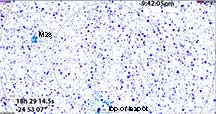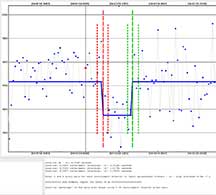

This event is not easy, but maybe not impossible. It crosses Santa Cruz almost centrally and is high rank. Karl is inside the path as well. The event lasts 6 seconds, otherwise I might not try it. 6 seconds is long enough to get useful size and shape data even with a long integration. Suggesting 16x or even 32x if needed. Skies look clear and perfect. The waning moon will be only 1 degree up in the east, and the event is due south, right above the top star of the Teapot of Sagittarius, and also within a degree of M28. After you've done your 2-star align, maybe just go to M28 and see if it's pointing well.
 |
 |
Nolthenius
I decided to try to make this a combo fun trip, to help motivate me to drive a ways, get south of the centerline and get a better astrometry result if Kirk, Karl and I all got positives. My thought was to drive to Salinas River State Beach, south of Moss Landing, which has deep soft sand which is a joy to run in. Maybe stop at that fruit/vege stand on Hwy 1 nearby and get great veges and fruit and nuts at a great price. Then get the occultation. However, as I drove south on Hwy 1, I could see fog coming inland around Moss Landing, and I made an instant decision to do Plan B: get off at Watsonville, drive down Beach Rd to Pajaro Dunes State Beach and do my daily run along the sand, then get the occultation from a few miles away. The run was a joy! I'd not been there before. Brought my PowerShot and fanny pack and got some nice pictures of sunset and scenes. But, it had a marine air feel to it - damp, cool, breezy. Not perfect for such a near record faint occultation only 28 degrees up. I considered trying to drive into the mountains behind Watsonville to get above the marine layer, but thought that would be too close to Karl and too high odds of a miss. Instead, I drove up San Andreas Rd a ways to gain a little altitude, and set up in a spot with minimal breeze and hoped for the best. The seeing was OK but not perfect. I needed 32x to see the target and settled with that for the occultation.
So far, I've not yet found a parameter set that gets a solution. I'm thinking I should have done 16x and had more points to work with.
I tried one more time: with a maximum 6.8 pixel aperture, 2-sigma threshold. 'Appsum' or 'signal', they both failed. Still nothing. Kirk's target star rides clearly above sky. Mine rides ~at sky. I had three strikes against me vs Kirk's.... 1. I was in the marine layer and high humidity means stronger extinction, already more than 2-atmospheres at alt=28. 2. the breeze caused poorer tracking during the long 32x integrations. 3. The secondary mirror was even more skewed than usual, visible on the playback with very oblong stars on the left side of the chip. The target was kept in the center and focus seemed OK, but the other problem is that the "donuts" when out of focus were very asymmetric. After the event, I used a screwdriver to adjust the 3 secondary mirror alignment screws and got the donuts looking more evenly illuminated. Too late to save this one, though.
However, there was definitely an occultation at my site, and consistent with Kirk's timings. This asteroid was slow-moving and my event should have been several seconds before his, which it was. The event is fairly definite on the series of 1-second 'finders' I've cropped and posted below, from PyMovie.
|
light=100% |
light=100% |
light=100% |
light=100% |
light=40% |
|
light=0 |
light=0 |
light=0 |
light=0 |
light=0 |
|
light=70% |
light=100% |
light=100% |
light=100% |
light=100% |
I determined the D and R times manually, in the following way. I assume the occultation occurs mid-'finder' if the light is 50%. Interpolating above then gives...
D time stamp for 50% light = 4:42:01.96
R time stamp for 50% light= 4:42:07.5
The finder images are 1 second long, or very close to two Watec integrations (32x setting). The midpoint of the 'finder' is therefore 0.5 sec later than the first field time stamp, which is that shown on the images. So...
D: 4:42:02.46
R 4:42:08.0
Duration 5.54 seconds and midpoint of 42:05.23
Kirk Bender (PyOTE log file)
Kirk set up at higher elevation, over 1000 ft, at the Bonny Doon Ecological Reserve. He had good conditions, and succeeded in getting a 4 second event passing the red bar test. Since he was north of the centerline, it suggests I should have a 5 or 6 second event at my site. Kirk's data was at 16x setting. 8 frames so 4 frames correction to add to these nominal times which is 0.13 seconds
Kirk's settings are of interest... his star is well above sky. Mine was buried in sky, yet I had 32x integration and he only 16x. What's up with that? The Watec 910hx I've loaned to him is better than mine, but THAT much better? Something else is going on. Better skies at higher elevation? He used the 'appsum' setting in PyOTE.
 |
 |
 |
 |
 |
D: 4:42:07.52
R: 4:42:11.52
so that's a mid-point of 09.52 which is 4.22 seconds later than mine, which is consistent with the estimate of 5 seconds from the OW predictions, although my site was farther north than my claimed site south of Moss Landing.